Overflowing with joy, biblical celebrations reveal deep spiritual truths and communal bonds—discover the stories behind these ecstatic events.
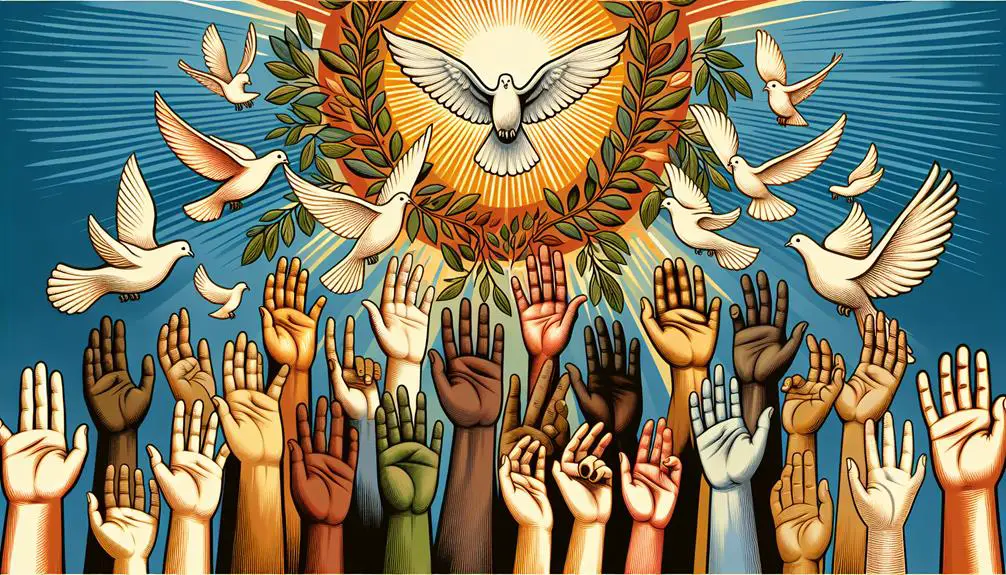
Joyful Celebration in the Bible
In the Bible, celebrations aren't just events; they're epic festivals that could probably outshine any modern-day party you've been to. You've likely heard tales of Miriam's dance by the sea or David's exuberant dance before the Lord, each a vivid testament to the joy and reverence these figures held for divine deliverance and blessing.
But what's truly fascinating is how these moments of jubilation weave into the broader tapestry of biblical narrative, offering insights into cultural, religious, and emotional landscapes of the time. To uncover the significance behind these joyful celebrations, one must explore the stories and the profound impact they had on the communities involved.
Key Takeaways
- Joy in the Bible spans from triumph over oppression to divine revelations, emphasizing communal worship and gratitude.
- Biblical celebrations, such as Miriam's Dance and the Feast of Tabernacles, illustrate the deep intertwining of joy, worship, and community.
- The Parable of the Prodigal Son teaches that joy arises from forgiveness, reconciliation, and restored familial bonds.
- Joyful celebrations in the Bible challenge contemporary notions of worship and highlight the role of joy in spiritual and communal life.
Miriam's Dance by the Sea
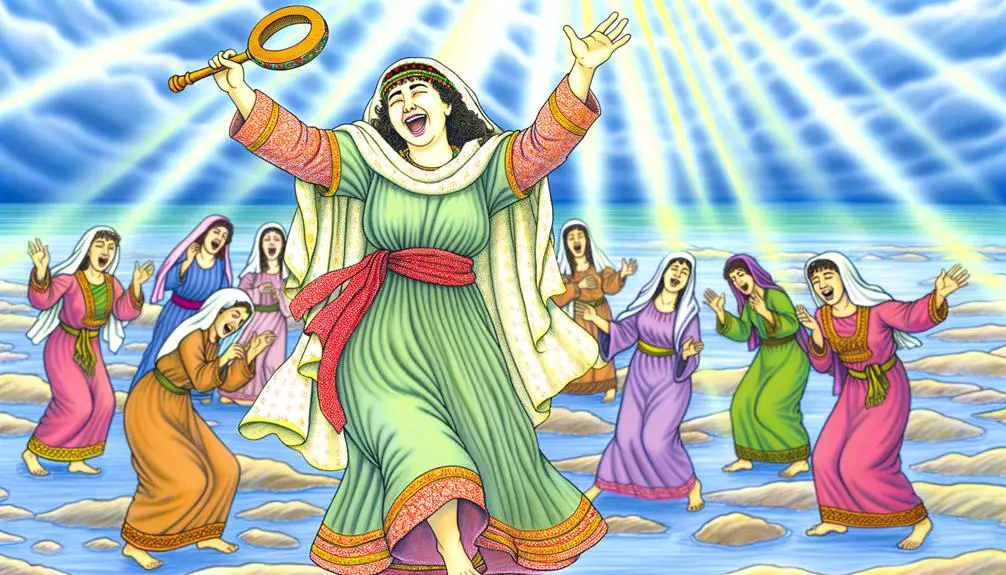
Miriam's dance by the sea represents a pivotal moment of triumph and spiritual celebration in the biblical narrative, showcasing the Israelites' jubilation after their escape from Egyptian bondage. This event isn't merely a spontaneous outburst of joy but serves as a profound demonstration of women's leadership within a religious context. Miriam, identified as a prophetess, leads the women in song and dance, signifying her pivotal role in guiding the community's spiritual expression. This moment highlights the significance of female leadership in ancient religious practices, challenging the often male-dominated narratives of spiritual leadership.
The incorporation of musical instruments, specifically 'timbrels' or tambourines, in this celebration, underscores the importance of music in communal worship and spiritual expression. Miriam and the women's use of these instruments is instrumental in facilitating the communal celebration, illustrating how music serves as a vehicle for expressing collective joy and triumph. The timbrels, therefore, aren't mere accessories to the dance; they're central to the act of worship and celebration, symbolizing the joyous liberation from oppression.
Analyzing Miriam's dance by the sea through the lenses of women's leadership and the use of musical instruments offers a nuanced understanding of the event. It reveals the multifaceted nature of biblical celebrations, where music and dance aren't only forms of artistic expression but also integral components of spiritual leadership and communal identity. This analysis underscores the enduring power of joyous celebration in fostering community cohesion and spiritual upliftment, anchored by strong female leadership and the resonant power of music.
David's Joyful Dance
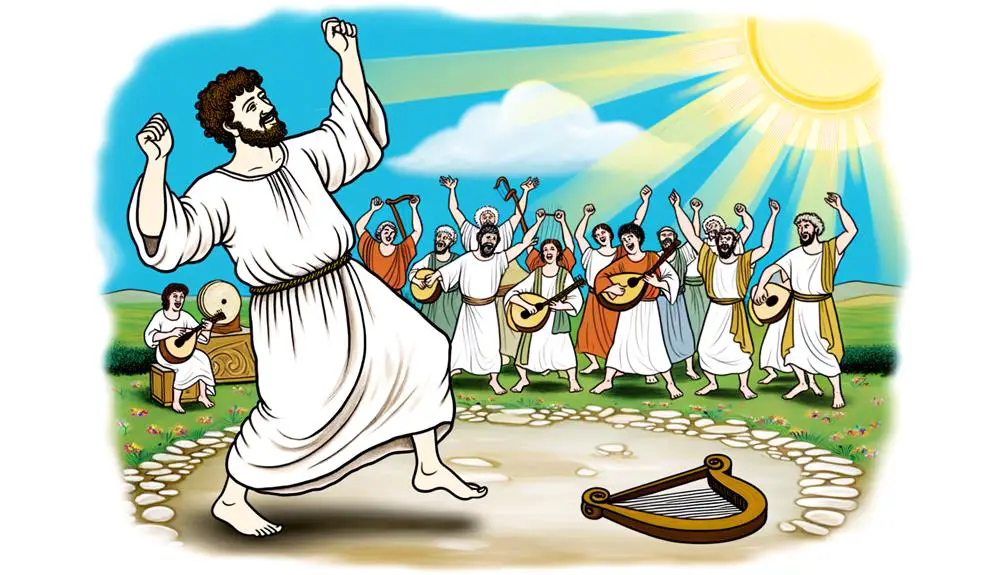
In a striking display of spiritual exuberance, King David's dance before the Ark of the Covenant epitomizes the profound intersection of religious devotion and communal celebration within the biblical narrative. This event, marking the Ark's return to Jerusalem, isn't merely an act of personal joy but a significant worship expression that underscores the integral role of expressive arts in spiritual practices.
David's dance, described in the Scriptures, transcends mere physical movement; it represents a heartfelt response to the divine presence and favor. As you delve deeper into this account, you recognize that David's choice to celebrate so publicly and unabashedly in the streets of Jerusalem reflects a theology of worship that's deeply embodied and communal. This act of worship wasn't confined to the inner courts of the temple but spilled out into the public sphere, involving the entire community in a shared experience of divine joy.
Moreover, David's dance challenges contemporary notions of dignity and decorum in worship settings. His willingness to 'become even more undignified than this,' as mentioned in the biblical text, suggests a prioritization of genuine expression of love and devotion over social conventions and personal image. This aspect of David's story invites a reevaluation of how worship expression is perceived and practiced today.
Analyzing David's joyful dance as a seminal biblical event also illuminates the broader theme of joy and celebration as integral to the human experience of the divine. In this narrative, the physical act of dancing becomes a metaphor for the soul's uncontainable joy in response to God's presence and promises. This account, therefore, enriches the tapestry of biblical examples of worship, highlighting the diversity and depth of expressions through which humans can connect with and celebrate the divine.
The Feast of Tabernacles
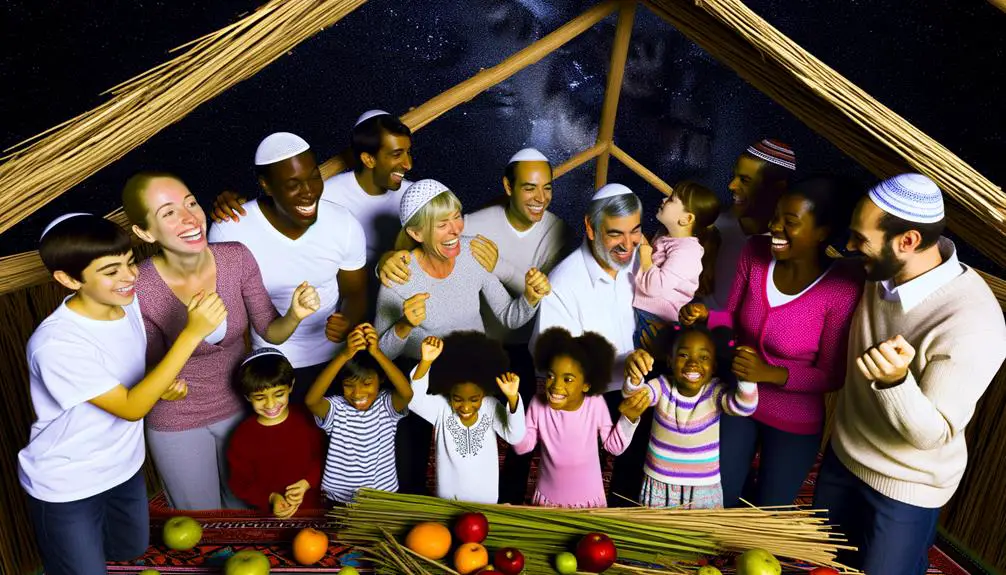
The Feast of Tabernacles, celebrated annually by the Israelites, embodies the nation's collective memory and gratitude for God's provision and protection during their wilderness wanderings. This week-long festival, also known as Sukkot, occurs in autumn, marking a time of joyful thanksgiving for the completed harvest. Its observance is deeply rooted in historical and agricultural significance, serving as a vivid reminder of the Israelites' reliance on God for their sustenance and safety.
Central to the celebration are the temporary dwellings, or sukkahs, that participants construct and inhabit. These fragile structures symbolize the transitory shelters used by the Israelites during their 40 years in the desert. Living in these temporary shelters for the duration of the feast fosters a sense of humility and dependence on God, reinforcing the festival's themes of trust and thanksgiving.
To create imagery in the audience's mind, consider these elements:
- Harvest Significance: Imagine fields ripe with produce, symbolizing God's bountiful provision. This festival occurs at a time when the storehouses are filled with the fruits of the land, a direct result of divine blessing and hard work.
- Temporary Dwellings: Visualize families gathering materials to build their sukkahs, structures that are intentionally fragile and open to the elements, reflecting the vulnerability and faith of the Israelites in the wilderness.
- Community Celebration: Picture the entire community coming together, sharing meals and stories in their sukkahs, united in gratitude and remembrance of their journey and God's enduring faithfulness.
Analyzing the Feast of Tabernacles reveals its profound significance in commemorating God's provision and protection. It serves as an enduring symbol of faith, gratitude, and communal unity.
Joy in the Birth of Christ
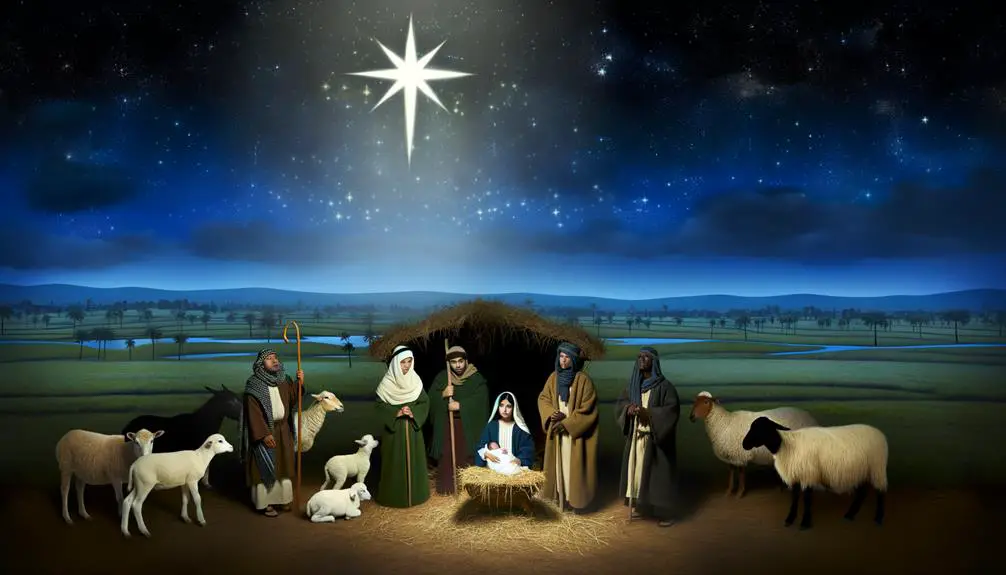
Shifting focus to another significant biblical event, we explore the profound joy surrounding the birth of Christ, an occasion that brought together angels and mankind in a unique celebration of divine intervention. The angel's announcement to the shepherds stands as a pivotal moment, symbolizing the breaking of divine news to the humblest members of society. This narrative element isn't merely a detail; it encapsulates the essence of joyous revelation, transcending social boundaries and emphasizing the inclusive nature of Christ's arrival.
The shepherds' visit, following the angel's guidance, further cements the theme of joy in this biblical account. Their immediate response, leaving their flocks to witness this miraculous event, illustrates a spontaneous outpouring of joy and faith. It's crucial to analyze this response within the broader context of biblical joy, where divine encounters prompt unreserved expressions of happiness and fulfillment.
This incident, rich in theological significance, also offers insights into the nature of true joy. Unlike transient pleasures, the joy depicted here is deeply intertwined with divine purpose and revelation. It challenges contemporary understandings of happiness, suggesting a model of joy that's rooted in spiritual awakening and communal participation in divine events.
Moreover, the angel's announcement and the shepherds' visit illuminate the role of joy as a catalyst for communal gathering and celebration in the biblical narrative. This joy isn't solitary but shared among those who witness and participate in God's unfolding plan. Through this lens, the birth of Christ emerges not only as a historical event but as a timeless source of joy, inviting continuous reflection and celebration among believers.
The Prodigal Son's Return
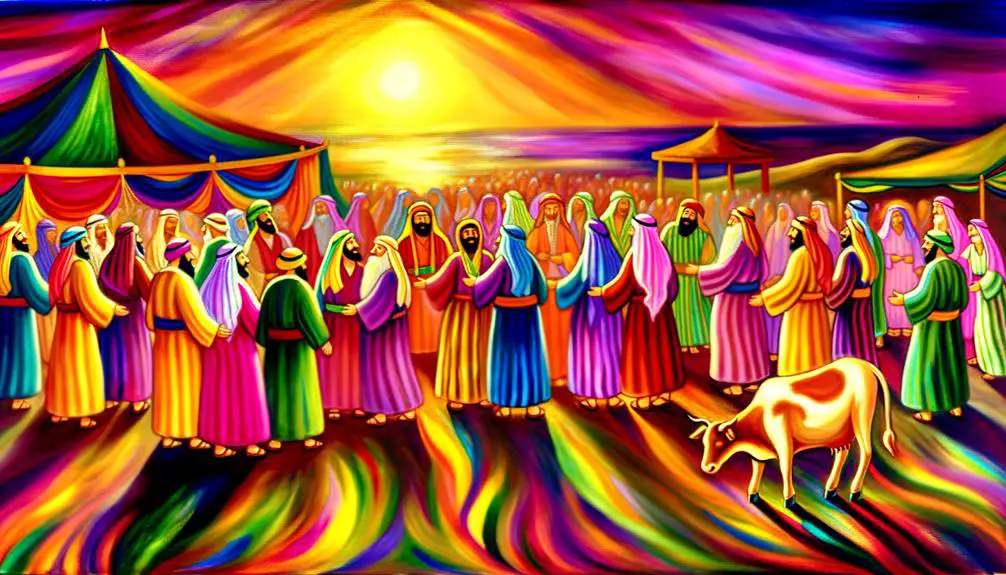
Amid the diverse narratives of joy in the Bible, the return of the Prodigal Son stands out as a profound exploration of forgiveness and reconciliation, revealing deep layers of spiritual joy. This parable, rich in symbolism and moral teaching, encapsulates essential forgiveness lessons, underpinning the fundamental values of family reconciliation. The narrative not only illustrates the boundless capacity for forgiveness but also underscores the jubilation that accompanies the restoration of broken relationships.
To create vivid imagery in your mind, consider the following elements:
- The father's compassionate embrace of his returning son, symbolizing unconditional love and forgiveness.
- The festive celebration organized in honor of the son's return, embodying communal joy and the renewal of familial bonds.
- The older brother's initial resentment, which serves as a critical reflection on human jealousy and the challenge of genuine forgiveness.
Analyzing the parable, it becomes evident that the core message revolves around the transformative power of forgiveness. It teaches that reconciliation can bring about a joy that transcends personal grievances, highlighting the importance of family unity over individual pride. The father's response to his younger son's return, devoid of condemnation, instead filled with joy and celebration, provides a powerful model for addressing estrangement within families.
Furthermore, the elder son's journey towards understanding and eventually accepting his father's actions encapsulates a secondary lesson on the complexities of human emotions and forgiveness within a familial context. This narrative, therefore, serves as a timeless guide for navigating the intricacies of family reconciliation, emphasizing that the path to true joy lies in forgiveness and understanding.
Frequently Asked Questions
How Do Modern Cultures Around the World Incorporate Biblical Concepts of Joy and Celebration Into Their Contemporary Festivities and Religious Observances?
You'll find that modern cultures globally weave biblical concepts of joy and celebration into their festivities and religious observances through cultural adaptations and festive foods.
They reinterpret ancient narratives, aligning them with contemporary values and traditions. This includes integrating symbolic foods that carry deep biblical significance into modern celebrations, thereby preserving the essence of biblical joy while adapting it to fit the context of today's diverse cultural landscapes.
What Psychological Impacts Does Participating in Joyful Celebrations Have on Individuals and Communities, Especially in the Context of Religious Faith?
When you dive into the heart of joyful celebrations, you're not just attending an event; you're embarking on a journey where neurological effects and cultural differences converge.
Participating in these gatherings, especially within a religious framework, has profound psychological impacts. It bolsters community bonds and enhances individual well-being. This isn't merely anecdotal; studies show that these experiences can lead to lasting positive changes in brain chemistry, fostering a sense of belonging and happiness.
How Have Depictions of Biblical Celebrations Influenced Western Art and Music Throughout the Centuries?
Biblical celebrations have significantly shaped Western art and music, leaving a profound impact.
You'll find sculptural inspirations in countless pieces, capturing pivotal moments with a religious fervor.
Choral adaptations, meanwhile, have breathed life into ancient texts, allowing them to resonate in modern ears.
These influences span centuries, demonstrating how deeply interwoven religious narratives are with the fabric of Western cultural expressions, enriching both visual and auditory art forms.
In What Ways Do Biblical Teachings on Joy Challenge or Complement Modern Understandings of Happiness and Well-Being?
You'll find biblical teachings on joy to be a double-edged sword when comparing them to modern concepts of happiness and well-being. While secular happiness often hinges on external circumstances, biblical joy, including the notion of 'joyful mourning,' delves deeper, suggesting a contentment rooted in faith and perspective.
This contrast challenges modern understandings, urging a reevaluation of what truly constitutes well-being beyond the superficial, and complements them by offering a more enduring form of happiness.
Can the Concept of Joy as Presented in the Bible Be Reconciled With Experiences of Suffering and Hardship, and How Do Theologians Interpret This Paradox?
You might wonder if you can find joy amidst suffering.
The Bible introduces concepts like 'joyful mourning' and 'sacrificial joy,' suggesting a deep, complex relationship between happiness and hardship.
Theologians see this paradox as reconcilable, arguing that true joy often coexists with, or even stems from, suffering.
This view challenges modern notions of well-being, emphasizing that profound joy isn't the absence of pain but can thrive alongside it.
Conclusion
In the tapestry of biblical narratives, celebrations erupt like vibrant blooms in a desert, symbolizing divine joy and human exultation.
From Miriam's rhythmic dance beside the Red Sea to the jubilant embrace of the Prodigal Son, these stories weave a pattern of redemption and rejoicing.
They serve as reminders that, in the shadow of divine providence, joy isn't only possible but promised, illuminating the path from despair to deliverance with the radiant glow of eternal hope.

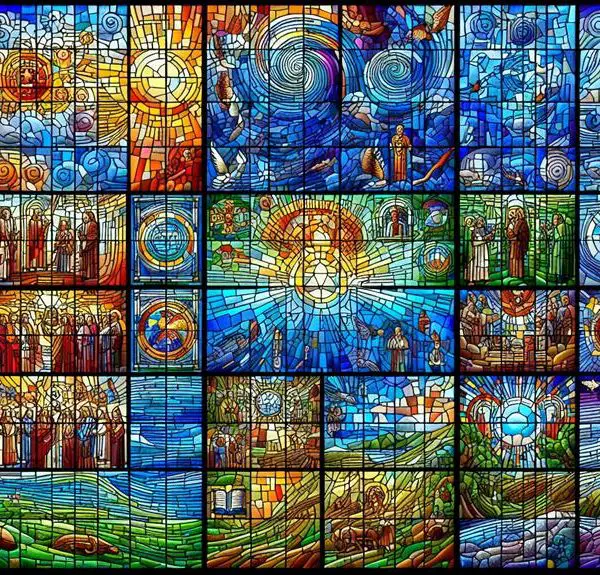

Sign up